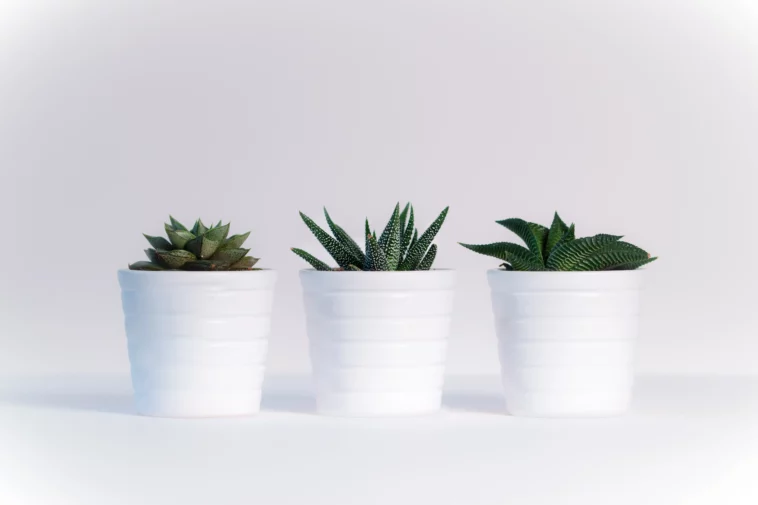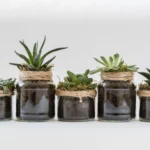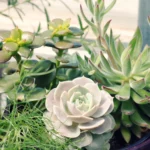Do you have a lovely cat? Are you thinking about getting a succulent plant? It’s natural to worry about things like that, but let’s clear a few things up for you, so you have a better idea of what plants will be safe for your cat.
For the most part, you don’t need to worry about your cat eating a succulent – they’re carnivores!
But you should still be careful if they’re young and playful, or you keep your plants near the cat food.
There are also some species of succulent that you need to be extra careful of: aloe vera, Euphorbia, Jade, Kalanchoe, and Senecio.
Table of Contents
What is a succulent?
To understand whether or not something is safe for anyone, you should first be aware of what it is. The fact you’ve clicked on this article suggests that you do have some idea of what a succulent is- a type of plant.
But this doesn’t narrow it down too well. After all, a sunflower is also a type of plant.
To be specific, a succulent is a drought-resistant plant. It’s able to store water in its leaves, stems and roots, so it doesn’t need to be watered as often as other plants do.
A great example of a succulent would be the snake plant.
Succulents are (generally) safe for cats
Generally speaking, most succulents are not dangerous for cats. And I’m sure at this point, some of you will be jumping for joy as it means you can now keep your plants without having to worry too much about your cats.
However, “safe” does not mean “edible”. Just because something is not toxic to have in a room does not mean you should be feeding it to your cat. You should always be careful about whether or not your cat is the kind of cat to get into your plant.
Thankfully, succulents are not very appealing to cats. First of all, they even smell or taste very nice at all. Would you want to eat one? Neither would they.
In LA, there are loads of Jade plants- a type of succulent that is slightly toxic. And even there, cats never try eating it.
Generally speaking, you don’t need to worry about your cat getting it’s claws on a succulent. They are carnivores, so eating any plant would serve no interest whatsoever to them. It’ll be like worrying about your horse getting sick from your bacon sandwich. It’s just very unlikely to happen.
Why you should still be careful
Playful cats
When cats are young, they tend to be incredibly playful. There are even some older cats who never grow out of it. These cats might play with your succulent, not because they want to eat it, but because they might think it’s a toy of some sort.
Should they get sap over their paws, they will likely try to clean themselves by licking it off. When this sap gets in their system, it might make them a bit poorly for a day or so. However, it shouldn’t be deadly.
Near food
Sometimes, plants break for reasons unrelated to your cats. Diseases, trimming, and a variety of other reasons. Most of the time, this is not going to be an issue. However, we understand that some people like to keep their cat food next to their plants.
Although unlikely, it might be worth being a bit careful about how close your cat’s food gets to your plants. If it’s just a tiny bit, it shouldn’t be anything to worry about, but if you’re feeding your cat sap covered cat food, this could make them very unwell.
The best thing to do would be to never leave your cat’s food uncovered.
Cats are not humans
It’s worth remembering that humans and cats are different. For example, your cat would be able to eat a whole raw chicken without any issue. We, on the other hand, do not have such a luxury. If we even took a bite, we would be on the toilet for hours and throwing up all night.
Likewise, we might enjoy a nice salad, but your cat will not be able to digest it. It’s always worth looking into the health effects on cats of the plant you’re thinking of buying. Just because you know people who have it on their desk does not automatically mean it will be safe for the cat.
Succulents that can be dangerous for cats
Aloe Vera
Aloe Vera is one of the most popular succulents. Not only does it look beautiful, but it can also help when you need your skin to soothe.
After your cat has surgery, you may find yourself wanting to add some aloe vera to soothe this area. Should you choose to do this, you will need to be 100% certain that your feline friend will not be licking it off.
If a cat licks Aloe Vera, they might become lethargic, start vomiting, and get diarrhoea. Or even begin peeing red.
Euphorbia
Euphorbia are also known as milk plants. Some of them can even grow beautiful flowers. The reason why they are known as milk plants is that their sap resembles milk. But it’s not! This sap is toxic to both cats and humans.
If you know your cat is a big fan of milk, be careful with these ones. They might lick some of the sap thinking it’s milk, and the consequences will jot be good.
Mouth irritation, stomach pain, vomiting, diarrhoea. None of that sounds good! Neither for you nor your cat.
Jade
Jade is a rubbery plant that’s known for being very hard to kill. This is one of the succulents that can be particularly dangerous for cats. It can lead to lethargy, clumsiness, dry heaving and vomiting.
Although your cat is unlikely to want to eat it, it might be wise to keep this one out of their reach if you have a playful cat. And make sure to keep it well away from your cat’s food.
Jade is a lovely plant, although it can be invasive in some parts of the world. So make sure to kill it if it turns up unannounced.
Kalanchoe
Kalanchoe is excellent for new plant parents. It looks nice, and it’s easy to look after. But if you have the kind of cat that would play with it, thinking it’s a toy, you might want to think twice before buying this one.
You may find that your cat has a sore mouth, distressed digestion, vomiting, or diarrhoea. And the really annoying thing is, they don’t get sick straight away. It can take from 12 hours to 5 days for the symptoms to show.
But for most cats, this is not going to be a worry.
Senecio
The Senecio is also known as the string of pearls. As you can probably tell by the name, it looks a bit like tiny beads on a string. And a lot of cats enjoy playing with tiny beads on a string. So this plant is a definite no no if your cat likes to play with string a lot.
Suppose they accidentally digest some of this while playing. In that case, they will find themselves with a lack of energy, throwing up, and unable to control their bowels.
Because most cats, no matter their age, wouldn’t say no to some beads on a string, we would say that if you have a cat, don’t get this plant.
Advice on keeping succulents away from cats
If you wish to get a succulent, and you have a cat, here’s some advice for what to do.
If you have a playful cat, try to keep anything that might look like a toy out of their reach. You should be okay, but it really isn’t worth the risk. Ensure that if you keep your cats food next to your plants, be sure to always cover the food. In fact, always be sure to cover the food anyway.
If you have a young cat who likes to tear up everything it sees, it may be worth thinking twice before getting any kind of succulent. Just wait till they grow up.
What to do if your cat eats a succulent
If your cat does ingest a succulent, particularly one of the toxic ones, and they become incredibly sick, it might be worth taking them to the vet.
Your vet will be able to tell you what the plant has done to the cat and what you need to do to sort the problem out. They might even give you some medication that you will need to feed your cat.
Conclusion
Generally speaking, succulents and cats are nothing to worry about. Not only will most of them give them a slight stomach ache at worst, but because cats are carnivores, they won’t even be interested in trying.
However, if you have a playful cat who seems to think that everything can be played with, you should think twice about the kinds of succulents you should have in your house. The consequences of your cat ingesting a succulent could be anything from a slight stomach ache to violent vomiting.
But, because you know your cat better than we do, we’re not going to be telling you what to do.
Photo by Ylanite Koppens from Pexels



